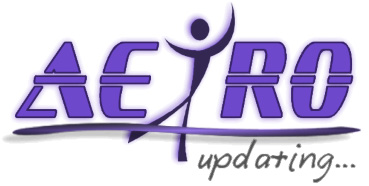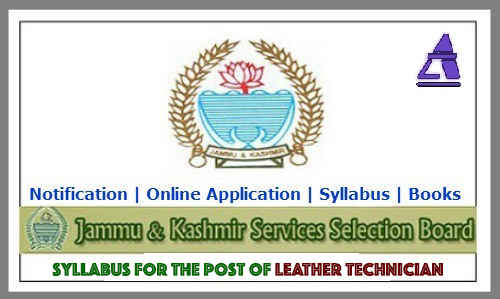Jammu & Kashmir Services Selection Board
LEATHER TECHNICIAN
Multiple Choice Based Written test
Reference Guidelines and Syllabus 120 Marks/120 Minutes
LEATHER MANUFACTURE – 25 MARKS
Flaying, availability, classification and grading, defects, anatomical structure, chemical composition and constituents of hides and skins. Proteins, Curing and Preservation. Pretanning & Post tanning operations.
Different types of tanning (chrome, vegetable, oil, aldehyde, alum, zirconium & combination Tannage). Selection of wet blue. Different Operations carried out in dye house & crust yard. Waterproofing & water repellent agents. Finishing (Machine Operations). Finishes (composition, classification, materials& techniques).
ORGANIC CHEMISTRY- 09 MARKS
Purification of organic compounds (crystallization) distillation and sublimation detection of elements(N.S and Halogens). Estimation of Hydrogen and sulphur.
Empirical and Molecular formulae. Isomerism (structural and stereo). Hydrocarbon saturated and unsaturated. Substitution and addition reactions. Chlorination of methane.
Aldehydes, Acids.
FOOTWEAR TECHNOLOGY- 18 MARKS
Foot Anatomy, Foot abnormalities, foot ailments, cures, Shoe lasts, Size systems, classifications/types of footwear, Designing and pattern cutting, Materials for insole, sole, adhesives, Pattern-layout, Clicking, Tools, equipments and machinery for footwear’s, Elementary knowledge of layout, cost analysis and marketing strategy for footwear unit.
TANNERY WASTE MANAGEMENT -13 MARKS
Sources, composition, types and characteristics of tannery wastes, Hazards created by untreated tannery effluents. Recovery and reuse of chrome from wastes chrome liquor, Elementary idea of different treatment methods ,primary secondary and tertiary, Sludge treatment and disposal, model treatment plants, Various solid wastes, their composition and characteristics
,Environmental problems in handling tannery solid wastes, Utilization and disposal of tannery solid wastes, Manufacture of Glue and Gelatin, Manufacture of Leather boards .
Remain Updated with all the Notifications from JKSSB. Like their Facebook Page below:
LEATHER TRADE ENGINEERING -07 MARKS
Selection of Site, Location – geographical background. Water and Pits. Power supply & boiler. Transmission of Motion and Power ( Belt drive, slipping of belts, power transmitted by belts).Drums and Paddles. General description/characteristics, foundation, installation, erection and commissioning of various tanning machinery like fleshing, unhairing, scudding, setting, shaving, splitting buffing, & stacking. Principles of working of various finishing machines, Conservation of Energy and Water
LEATHER PROCESS TECHNOLOGY -19 MARKS
Study of raw Cow & Buffalo hides and calf skins, their selection / grading as per end use.
General practices in vegetable tanning. Pit tanning and drums tanning. General practices in chrome tanning. Wet white – properties & general methods of manufacture.
Vegetable tanned and Chrome tanned sole leathers. Water proofing of sole leathers.
Belting leathers, Picking band leathers. Football & cricket ball leathers. Nubuck, suede & dry milled leathers. Finished Leathers and Composition of Finishes .Finished Leathers from Hair Sheep and Wool Sheep Skins. Exotic leathers, furs, Morocco, pleated leathers, book binding and chamois leathers. Reptiles leathers from Crocodiles, Lizards, etc. Dressing of fur skins. Up gradation of Leathers. Up gradation through special effects by Embossing, Snuffing & Buffing, General concepts of eco-friendly processing of leathers with cleaner beam house operations, Chrome / mineral free alternative tanning system, processing leathers with cleaner post tanning and finishing operations.
TESTING & QUALITY CONTROL- 12 MARKS
Curing and pre-tanning chemicals including spent liquors. Vegetable tanning materials and extracts. Chrome liquors and Chrome Tanning Components. Aluminum and Physical testing help in analyzing quality of leather as per norms. zirconium tanning salts, pH measurements, indicators and their use in testing. Physical testing of various types of leathers for tensile strength, elongation, dynamic water absorption, abrasion resistance, rub fastness, shrinkage. Use of instruments such as spectrophotometer, colorimeter, ion exchange resins etc in testing of tanning chemicals. Conservation of chemicals and water in the tannery. Analysis of limed and pickled pelts and chemical testing of vegetable tanned /chrome tanned leather. Analysis of chrome leather, vegetable tanned leather. Analysis of combination tanned leather for their constituent. Quality control in leather processing, role of testing in process and quality control specification (physical and chemical) from various types of leathers.
ESTIMATING & COSTING- 04 MARKS
Principles of calculating quantities of materials required for the manufacture of different types of footwear and leather goods, classification and distribution costs raw materials, labor, plant, overheads, wastes, packing and forwarding costs. Estimation of the costs of manufacturing different types of leathers and processes involved in leather manufacture
Price structure and marketing, foreign trade in raw hides and skins. Different types of leathers, stores management, packing and dispatch. Costing of various types of leathers, import, export policies, Incentives, drawbacks.
ANALYTICAL CHEMISTRY OF LEATHER MANUFACTURE- 18 MARKS
Principles of analytic methods employed in analysis of water. Effect of hardness of water on various processes in leather manufacture-Softening of water. Analysis of Various Chemicals and Auxiliaries used in Leather Processing. Salt, lime. Analysis of Fresh and Used Liquors of Beam House Processes. Analysis of Tanning Agents. pH measurement, indicators and their uses in testing. Instrumental Methods of Analysis used in Leather Chemistry. Spectrophotometry and colorimetry, ion-exchange resins etc. In testing of tanning chemicals.




